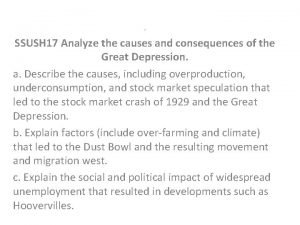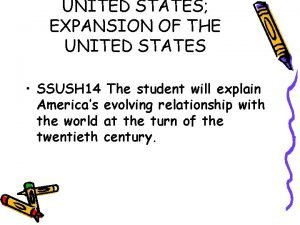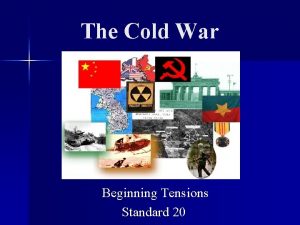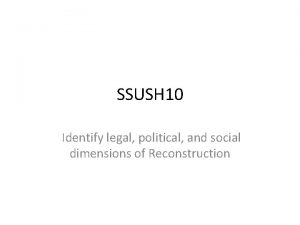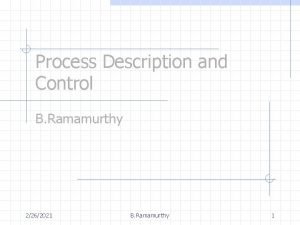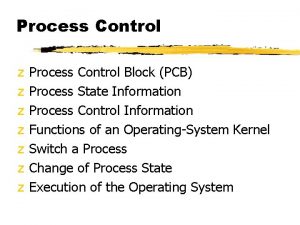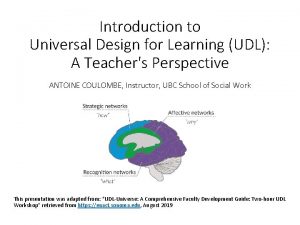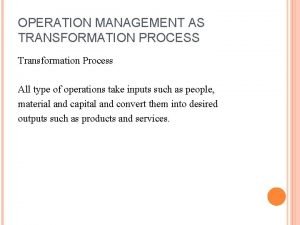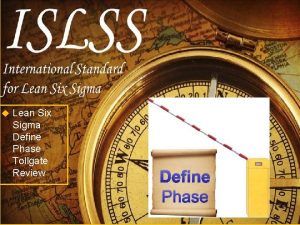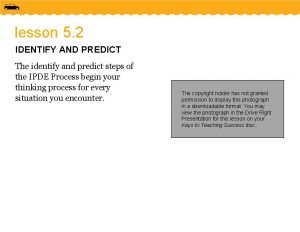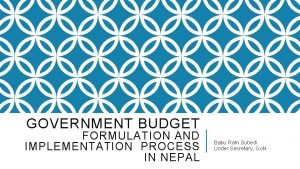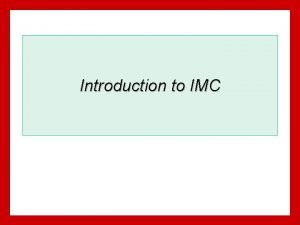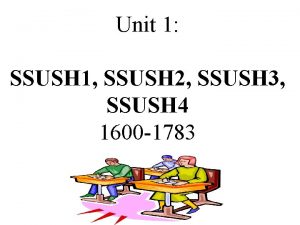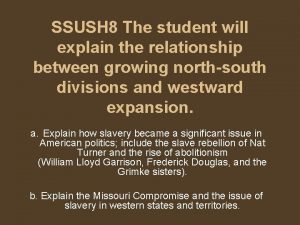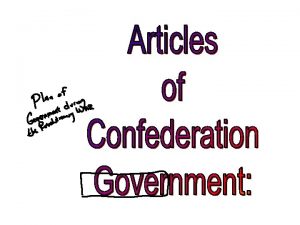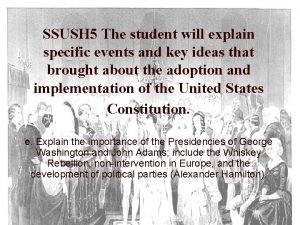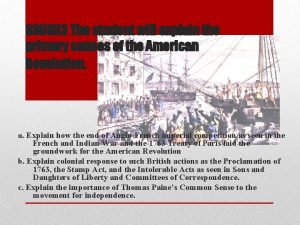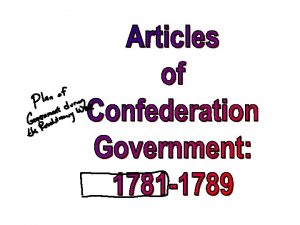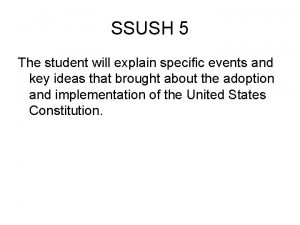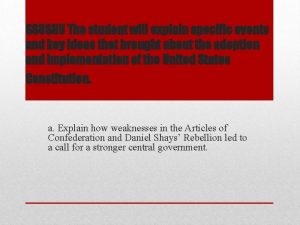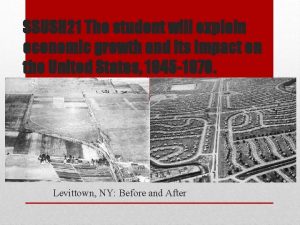SSUSH 7 The student will explain the process















































- Slides: 47

SSUSH 7 The student will explain the process of economic growth, its regional and national impact in the first half of the 19 th century, and the different responses to it.

SSUSH 7 a. Explain the impact of the Industrial Revolution as seen in Eli Whitney’s invention of the cotton gin and his development of interchangeable parts for muskets.

Industrial Revolution§ Began in Britain in the 1750 s and marked the beginning of the “industrial age. ” § The “revolution” occurred as machines replaced man-made goods by mass production. § Began in the United States in the 1790 s.

Inventors & Inventions Eli Whitney. New England inventor whose cotton gin and use of interchangeable parts revolutionized United States industry in the 1790 s. Interchangeable Parts. The use of replacing parts with replicas of original pieces (e. g. Muskets).

Inventors & Inventions Cotton Gin§ Machine which allowed the cotton to be pulled apart from the seed. § Revolutionized the cotton industry by lowering the cost of cotton production. § Created “King Cotton” in the South. § Perpetuated slavery.

Inventors & Inventions Samuel F. B. Morse. Invented the electric telegraph and code in 1837 sparking a surge in communications. John Deere. Invented the steel plow increasing the production of crops on farms.

Inventors & Inventions Cyrus Mc. Cormick. Inventor of the mechanical reaper which increased farm production by 1840. Isaac Singer. Inventor of the sewing machine which allowed the production of clothing in the home.

SSUSH 7 b. Describe the westward growth of the United States; include the emerging concept of Manifest Destiny.

Manifest Destiny expansion • 1840’s ______ fever gripped the country • Americans began to believe their movement westward and southward was destined and God ordained by _____ • “Manifest Destiny” – John L. O’Sullivan “the belief that the U. S. ’ destiny was to expand to the Pacific ____ Ocean and into Mexican territory”

Motivations for Expansion land • The desire of most Americans to own _______. gold • The discovery of ____ and other valuable resources. States United • The belief that the __________ was destined to stretch across North America (Manifest Destiny). Economic 1. _____ motivations Racist beliefs about Native Americans and 2. _______ Mexican people.

Mexican-American War—American settlers in Texas fight to take Manifest control of what had been Mexico-controlled Texas. The U. S. Destiny: eventually adds Texas as a state. When Mexico refuses President the Mexico, Polk’s offer to buy Mexican land, Polk picks a fight with USA thus starting the Mexican American war. M has Indian Removal Act—in order LOUISIANA the to gain land in. PURCHASE the West, the 1803 of Tears—relocation of Trail right USA government took Native Cherokee Indians from to Georgia American land relocated to Oklahoma reservations move Indians into reservations Gold Rush—gold was West Louisiana Purchase—President Thomas discovered in California and Jefferson bought miles in 900, 000 1849 which ledoftoterritory a get in Louisiana from France for $15 million. Lewis massive movement larger and Clark explored this territory. of settlers

SSUSH 7 c. Describe reform movements, specifically temperance, abolitionism, and public school.

TEMPERANCE MOVEMENT Prohibition or limit of alcohol ISSUE: People should drink less alcohol or it should be completely outlawed

The Drunkard’s Progress

TEMPERANCE MOVEMENT IMPACT: • per capita consumption cut in half between 1820 and 1840 • Protest church organizations gain influence • Women played a key role, leads to the women’s movement

EDUCATION REFORM ISSUE: • Many areas didn’t have free public schools • School year was short • Teachers were untrained Horace Mann led the reforms in Massachusetts. Other states followed.

EDUCATION REFORM IMPACT: • Established the right of all children to an education • More tax supported public schools • Improved education by required teachers to be trained reforms were still limited 1. no mandatory attendance 2. improvements only for white males 3. South far behind Northern advances

ABOLITION Definition: the action or an act of abolishing a system, practice, or institution. ISSUE: • Abolitionists wanted to outlaw slavery. IMPACT: • Created a very controversial political issue over the future of slavery in the territories • Made Southerners defend slavery more strongly.

SSUSH 7 d. Explain women’s efforts to gain suffrage; include Elizabeth Cady Stanton and the Seneca Falls Conference.

WOMEN’S RIGHTS Situation that existed 1. lacked legal & social equality --could not vote (suffrage) sit on juries, own property, earn her own salary, no legal protection from abuse, not guardian of the children 2. “cult of domesticity”--women were valued as the moral guardians of the home, family, & society

WOMEN’S RIGHTS WHAT WOMEN WANTED: Full citizenship • Voting rights • Parental and custody rights KEY LEADERS: Elizabeth Cady Stanton Lucretia Mott

SENECA FALLS CONVENTION Seneca Falls, NY Led by: Lucretia Mott & Elizabeth Cady Stanton adopted a “Declaration of Sentiments” • Declaration of Women’s Rights, including the right to vote (suffrage) • modeled on the Declaration of Independence IMPACT: • very few small changes • overshadowed by the bigger issue of Abolition


SSUSH 7 The student will explain the process of economic growth, its regional and national impact in the first half of the 19 th century, and the different responses to it.

SSUSH 7 e. Explain Jacksonian Democracy, expanding suffrage, the rise of popular political culture, and the development of American nationalism.

Election of 1824 Presidential Election of 1824§ The rise of sectionalism began with the election candidates: -- John Quincy Adams (Massachusetts) -- William Crawford (Georgia) -- Henry Clay (Kentucky) -- Andrew Jackson (Tennessee) § The Election was a tie (no candidate won the majority) and the election was decided by the House of Representatives.

Election of 1824 “A Corrupt Bargain”

Election of 1824 “Corrupt Bargain”§ Only the top three candidates of the race were voted on by the House of Representatives. § § Crawford dropped out due to health reasons. Henry Clay backed John Quincy Adams because of personal feelings toward Andrew Jackson. § Clay made a deal to became the Secretary of State under Adams if the members of the House would vote for Adams § Jackson supporters labeled the move a “corrupt bargain” because they felt the election was “stolen” from Jackson since he had the most votes

President John Quincy Adams 6 th President 1825— 1829 Party: National-Republican Home State: Massachusetts Vice President: John C. Calhoun

Adams’ Unpopularity Unpopular Presidency§ Adams’ presidency was very disappointing as Andrew Jackson’s supporters in Congress made life difficult for the new president. § Andrew Jackson Led to a very contested race in 1828.

Rise of Democracy Rise of the Jacksonians. Jackson’s supporters generally were southerners and westerners who favored “universal suffrage” who favored the right to vote for all white males, not just land owners.

Election of 1828 § The race was heated as both Jacksonians and supporters of Adams traded negative ads in newspapers. § First election with Campaign buttons, Rallies, & slogans were used § The challenger, Jackson, carried the South and the West, while the incumbent, Adams, carried New England. § Jackson easily won the presidency.


A New Political Party Jackson’s supporters broke with the Democratic-Republicans and formed the modern-day Democratic Party.

President Andrew Jackson 7 th President 1829— 1837 Party: Democratic Home State: Tennessee Vice President: John C. Calhoun & Martin Van Buren

President Andrew Jackson Domestic Foreign § Indian Removal Act of 1830 § Texas Revolution (1835) § “Nullification Crisis” (1830— 1832) § Annexation Debate over Texas § (Second) National Bank War (1832 --1837) § “Trail of Tears” (1836— 37) § Formed the Democratic Party (1832) § Nickname – “Old Hickory” (1835— 1837)

Jacksonian Democracy When Jackson entered office, he encouraged the use of the “spoils system” He replaced the gov’t officials from previous administrations with his own loyal party supporters (many were his personal friends) Spoils System. The policy of rewarding political supporters with positions within the government.

Indian Removal

By the time Jackson entered office, Americans were spreading West in search of new land to cultivate Five “civilized tribes” in the South stood in the way of American westward expansion The discovery of gold in north Georgia in 1828 led the Georgia government to seize Cherokee lands The Cherokee sued in the Supreme Court (Cherokee Nation v. Georgia) and won https: //www. youtube. com/watch? v=y. UILURVo. Phw

War on Native Americans Worcester v. Georgia (1832)§ Supreme Court case which supported the Cherokee Nation to remain in Georgia, but Jackson snubbed the decision. § Chief Justice John Marshall battled Jackson in a war of words over the decision.

War on Native Americans Indian Removal Act of 1830§ Under the Act, the United States forced Native Americans off its traditional lands in support of white settlement. § Native Americans were forced west of the Mississippi River. § Fighting broke out, but many nations peaceably migrated.

War on Native Americans: Indian Removal Act of 1830

War on Native Americans Trail of Tears (1837— 38)§ Forced relocation of Georgia’s Cherokee Nation to Oklahoma. § During the forced migration, nearly 25% died due to disease and starvation.

The Trail of Tears 1. 2. 3. How does this political cartoon depict Jackson? How are Native Americans depicted in this cartoon? What is the overall message of this political cartoon?

Practice Question Which group was forcibly relocated by means of the “Trail of Tears”? A) Mexicans B) Shoshone C) African slaves D) Cherokee

Practice Question The outcome of the election of 1824 between John Quincy Adams and Andrew Jackson was decided by A) the Electoral College B) the Senate C) the House of Representatives D) the “corrupt bargain”

Practice Question Andrew Jackson supported the spoils system because he believed it A) Brought into government the country’s most educated people B) Opened up government to more ordinary people C) Encouraged good workers to stay in their government jobs D) Attracted young thinkers into public service
 Ssush
Ssush Ssush
Ssush Ssush
Ssush Ssush
Ssush Ssush
Ssush Ssush
Ssush King of england during revolutionary war
King of england during revolutionary war How's your last weekend
How's your last weekend We ...... a big piece of wood last saturday. (see)
We ...... a big piece of wood last saturday. (see) National student clearinghouse student tracker
National student clearinghouse student tracker Class maths student student1 class student string name
Class maths student student1 class student string name National student clearinghouse student tracker
National student clearinghouse student tracker Freckle.student.login
Freckle.student.login Teacher good morning
Teacher good morning Student leaning space
Student leaning space The lifelong process of social interaction
The lifelong process of social interaction Selection objectives
Selection objectives Explain the process control block
Explain the process control block Unix process state transition diagram
Unix process state transition diagram Explain the process of udl.
Explain the process of udl. Explain the process of communication
Explain the process of communication The role of imc in the marketing process
The role of imc in the marketing process Project portfolio management process steps
Project portfolio management process steps Measuring the actual performance
Measuring the actual performance Steps in business research process
Steps in business research process Software configuration management audit
Software configuration management audit Explain operations as a transformation process
Explain operations as a transformation process Define tollgate
Define tollgate Making driving judgments involves
Making driving judgments involves Explain the process of budget formulation in nepal
Explain the process of budget formulation in nepal Explain what is meant by selective use of the ipde process
Explain what is meant by selective use of the ipde process Explain the process of ultrafiltration
Explain the process of ultrafiltration Ward delimitation 2020
Ward delimitation 2020 What is the nursing process
What is the nursing process What are the process of controlling
What are the process of controlling Diagram of process of communication
Diagram of process of communication Hình ảnh bộ gõ cơ thể búng tay
Hình ảnh bộ gõ cơ thể búng tay Slidetodoc
Slidetodoc Bổ thể
Bổ thể Tỉ lệ cơ thể trẻ em
Tỉ lệ cơ thể trẻ em Voi kéo gỗ như thế nào
Voi kéo gỗ như thế nào Tư thế worm breton
Tư thế worm breton Bài hát chúa yêu trần thế alleluia
Bài hát chúa yêu trần thế alleluia Các môn thể thao bắt đầu bằng tiếng bóng
Các môn thể thao bắt đầu bằng tiếng bóng Thế nào là hệ số cao nhất
Thế nào là hệ số cao nhất Các châu lục và đại dương trên thế giới
Các châu lục và đại dương trên thế giới Công thức tiính động năng
Công thức tiính động năng Trời xanh đây là của chúng ta thể thơ
Trời xanh đây là của chúng ta thể thơ
